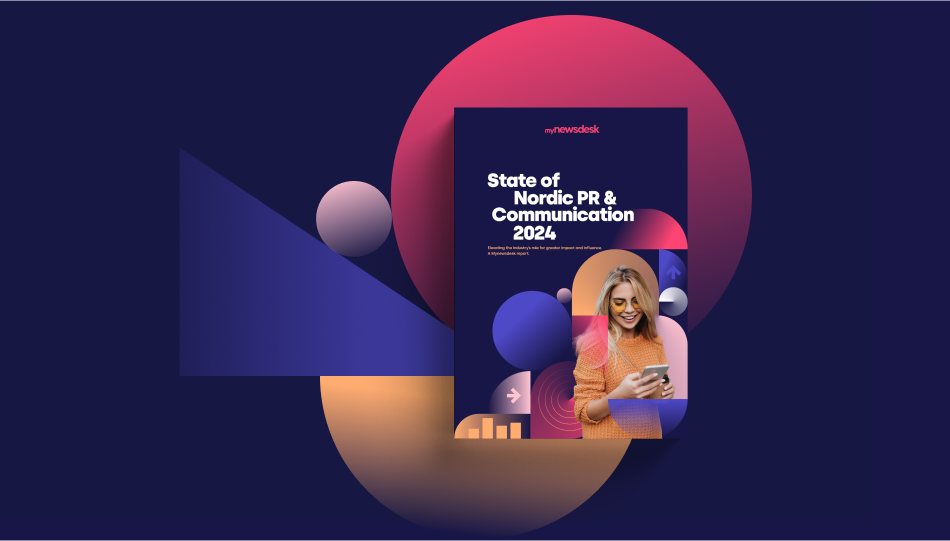Are you ready to get serious about your PR efforts? In that case, this blog post is a must-read! Learn what a PR strategy is, how to create a PR strategy that resonates with your target audience, and explore crucial elements such as identifying PR goals. Get started with your public relations strategy today!
What is a PR strategy?
A PR strategy, or PR plan, is a framework for planning, creating, and distributing content to engage the media, influencers, and other core audiences to convey your message on your behalf to help boost credibility. These third parties will add richness to your content by creating conversations and debates around what might otherwise seem unimportant. It’s the engagement of these third parties that is the key to your PR plan.
Most of your success will also depend on your ability to “sell” your content, usually to journalists, with the hope that they will pick up your story and amplify it to their own audience – all for the benefit of your brand. You can learn more about how to get journalists to cover your story in this blog post.
PR plan template
Continue reading to find out everything you need to create a great PR strategy or PR plan, or simply follow our step-by-step PR plan template. It’s packed with tips and inspiration on how to build your plan to help you succeed.
Planning a PR strategy
Before you start working on your PR strategy, make sure to do the groundwork. You probably have a lot of insights from your current situation that you can and should take learnings from. Here are a few things you can look into before you get started to set yourself up for success:
SWOT analysis
SWOT stands for Strengths, Weaknesses, Opportunities, and Threats. It is a planning tool and an approach to specifying what needs to be done to develop a company. One of the main purposes of a SWOT analysis is to identify the factors that stand in the way of achieving set goals. With a fairly simple framework, you can map strengths, weaknesses, opportunities, and threats. It often involves testing and weighing up many different factors.

Your PR purpose
Let’s take a step back before diving deeper into the public relations strategy. What is the purpose of your PR efforts? The purpose of PR, in general, is to connect with important audiences to help start conversations about your brand outside of your own channels. Any marketer knows that word-of-mouth is the most effective way of creating brand recognition and trustworthy relationships with your audience. When others speak well of you or your content, it is more powerful than when you do it yourself. That is what PR is all about. With that being said, why is your brand investing in PR?
If you find this question difficult to answer, you could start with understanding your current market position. Media monitoring is a great way to do so, as it keeps you up to date with what’s being said about your company and your products or services. You can also keep an eye on your competitors or your industry in general. With this as a starting point, your overall PR purpose could become clearer.
Do you want to increase brand awareness? Improve the sentiment of your brand? Reposition yourselves on the market? Once you have established your reasons for communicating, the rest will be much easier. It will help you determine what your goals should be centered around and who you want to target.
Determine PR goals, objectives, and KPIs
Setting clear objectives is essential for following up and measuring your PR efforts. How else will you know if you are on the right track? One of the biggest selling points of a digital PR strategy is that it can be comprehensively measured, which makes it easy to see if your PR efforts have the desired effect. In order to evaluate, though, you need to know what goals you’re trying to achieve. Be as specific as possible in defining what you’re measuring and how.
Whenever you set a goal, you must also identify how it will be measured to determine if your efforts are paying off. For example, you can’t state that you want your digital PR activities to ‘raise awareness of the company’s new product.’ You must be specific and attach numbers, such as ‘to create buzz for our new product, we will secure 25 online mentions from our target media and ten online reviews from our target influencers in the next three months’.
While some goals will be long-term, others will be short-term. For example, the former can be focused on where you want your brand to be in a year, while the latter is relevant when it comes to specific initiatives, like targeted PR campaigns or similar. Either way, you can use KPIs such as:
- Mentions – number of media mentions
- Reach – number of potential readers
- Sentiment analysis – if the media is positive, negative, or neutral towards you
- Ad value – the potential value of your earned media
Do you want to dive deeper into these metrics and see how they can contribute to your success? Our brand report is perfect for long-term impact PR KPIs. If you’re looking to evaluate short-term PR KPIs, our coverage report provides everything you need.
Make a PR distribution plan
The traditional PR channels have been events or press releases, which are, of course, still important. However, the digital landscape has changed the playing field, and you need to extend your PR efforts so that people can build relations with you online as well.
To reach your target group, you need to communicate with them where they consume digital information. No matter how relevant your messaging is, your audience won’t see it if you don’t. Your target audiences have their communication preferences – email, social media platforms, push notifications and so on. They also have their preferred devices – smartwatch, phone, tablet, laptop or desktop. Make sure you adapt to their preferences. Also, ensure your message reflects the selected digital platform’s preferred format, length, and tone.

Here are some ways to reach your audience:
An online newsroom
Publishing your content in an online newsroom is a great way to reach and build relations with the media, your audience, and other important stakeholders. This way, all your news is easily accessible to anyone interested in following your brand or industry. This is a strong foundation for any PR strategy!
Social media
It’s no secret that social media has become one of the most important tools in PR. Social media allows you to be personal, engaged, and real with your audience. Instant feedback about your content will quickly teach you what people like and dislike.
Influencer marketing
We are all aware of the impact influencers can generate. They have the power to influence hundreds, thousands, or even tens of thousands of followers with their opinions. Therefore, including influencer marketing in your PR strategy is definitely one way to boost your efforts.
Search engines
By understanding what your audience is interested in, you can utilize SEO to ensure that you appear in the search engines for important keywords. Build your own strong domain or take advantage of other publishing solutions with high domain ranking (like Mynewsdesk). This ensures that search engines like Google will favor the content you publish, meaning it will have a much greater chance of showing up on the first pages of their search results than if you posted the same content on a different platform.
Online and offline events
Events are a good way to interact with your audience. Both you and your audience get something out of it – which is key to building relationships –, whether it’s a live event or a webinar.
Online articles and guest posts
Collaborate with others by offering guest post content with valuable insights and thoughts on other platforms. This way, you can establish your brand as a trusted advisor and gain valuable backlinks, increasing traffic to your digital platforms.
Define PR target audiences
By knowing your audience’s needs and behaviors, you can create relevant, engaging content and build loyal, solid relations. When talking about PR, there are two main audiences that you need to be aware of: the people that you hope will share your message initially (journalists and influencers) and the ones that they will end up sharing it with (readers, followers, and so on). Let us dive deeper into how they differ and how you can approach them differently.
Media, journalists and influencers
Building relations with the media is about being relevant and making it easy for them to spread your brand’s news and stories. Think about how to pitch your story best and what people would be interested in covering it. You can use media contact databases to find them.

Final target group
These are your actual and potential customers that the above-mentioned PR target audience is trying to reach. This is probably the target audience you’re used to communicating with while working on your marketing activities. Even though you probably think everyone fits in this category – since everyone should understand how amazing your product or service is –resist the temptation to target multiple audiences. Pick one or two target groups, and when pitching your piece to media, make clear what interests your final target audience. This will enable their publications to be more customized and aligned to that group’s needs and wants, thereby better resonating with your end-customers.
Outline key messages for PR efforts
Now that you know what you want your PR strategy to accomplish, it’s time to think again about your audience. What content can your company offer to help or entertain your audience that relates to their daily lives and connects to your strategic PR goal? Compile the list of topics and craft relevant messaging. Put yourself in your audience’s heads and ask: ‘Why would I care about [insert your topic/message]?’ If you struggle to find the answer, choose a new topic or message.
PR budget
While many think of a budget as something restricting, it is there to help you. A PR budget will guide you regarding specific campaigns and the entire year, making sure you allocate your resources effectively. When you know what you have to spend, making prioritizations will be easier. Start by ensuring your essentials are in place. Do you have access to a journalist network? How are you distributing your content? Can you follow up on the results? Using PR software is a smart and efficient way to get that information.
Once the necessities are under control, you can start looking at more specific budget questions. Can you afford a live event, or should you make it into a webinar instead? Is bringing in a PR agency or keeping your activities in-house the best idea? When questions like these arise during the creation of your PR strategy, a budget will help you answer them. Plus, if you don’t know your budget, setting and evaluating goals will be more challenging.
PR strategy in summary
In conclusion, developing a thorough PR strategy is crucial for building brand recognition and fostering strong connections with your audience. It all starts with setting clear goals; based on that, you can define target audiences, craft compelling key messages, and distribute them using the right channels. This way, your PR plan will resonate with your audience and contribute to your brand’s short-term and long-term success.



